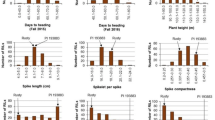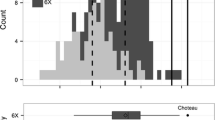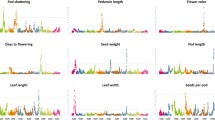Abstract
Wheat domestication and subsequent evolution under domestication occurred since the dawn of agriculture and caused significant genetic changes that affected plant morphology, physiology and phenology. The majority of these traits are quantitative traits controlled by many genes. Correspondingly, the main goal of the current study is genetic dissection of the key domestication trait (brittle rachis) and traits evolved under domestication, based on quantitative phenotyping. Genetic mapping of quantitative trait loci (QTL) affecting brittle rachis, threshability, threshing efficiency, spike harvest index and kernel weight was conducted using a recombinant inbred lines population derived from a cross between Triticum durum and wild emmer wheat. Using a new quantitative phenotyping approach, we discovered novel QTLs underlying rachis fragility, spike threshability and other domestication-related traits and confirmed some of the known putative locations for QTLs affecting these traits. Overall, the number of domestication-related QTLs mapped to the A genome was twofold higher than those found on the B genome, in accordance with the concept of ‘genome asymmetry’, implying that the A genome is dedicated to the control of morphological traits, house-keeping metabolic reactions and yield components. Our results add a new dimension to this important concept and contribute to a better understanding of the initial steps of domestication evolution of cereals.


Similar content being viewed by others
References
Abbo S, Lev-Yadun S, Gopher A (2010) Yield stability: an agronomic perspective on the origin of Near Eastern agriculture. Veg Hist Archaeobot 19:143–150
Abbo S, Lev-Yadun S, Gopher A (2012) Plant domestication and crop evolution in the Near East: on events and processes. Crit Rev Plant Sci 31:241–257
Abbo S, Pinhasi van-Oss R, Gopher A, Saranga Y, Ofner I, Peleg Z (2014) Plant domestication versus crop evolution: a conceptual framework for cereals and grain legumes. Trends Plant Sci 19:351–360
Avni R, Nave M, Eilam T, Sela H, Alekperov C, Peleg Z, Dvorak J, Korol A, Distelfeld A (2014) Ultra-dense genetic map of durum wheat × wild emmer wheat developed using the 90K iSelect SNP genotyping assay. Mol Breed. doi:10.1007/s11032-014-0176-2
Brenchley R, Spannag M, Pfeifer M, Barker GL, D’Amore R, Allen AM, McKenzie N, Kramer M, Kerhornou A, Bolser D, Kay S, Waite D, Trick M, Bancroft I, Gu Y, Huo N, Luo MC, Sehgal S, Gill B, Kianian S, Anderson O, Kersey P, Dvorak J, McCombie WR, Hall A, Mayer KF, Edwards KJ, Bevan MW, Hall N (2012) Analysis of the bread wheat genome using whole-genome shotgun sequencing. Nature 491:705–710
Briggs WH, McMullen MD, Gaut BS, Doebley J (2007) Linkage mapping of domestication loci in a large maize-teosinte backcross resource. Genetics 177:1915–1928
Dvorak J, Akhunov ED, Akhunov AR, Deal KR, Luo M-C (2006) Molecular characterization of a diagnostic DNA marker for domesticated tetraploid wheat provides evidence for gene flow from wild tetraploid wheat to hexaploid wheat. Mol Biol Evol 23:1386–1396
Ellegren H (2014) Genome sequencing and population genomics in non-model organisms. Trends Ecol Evol 29:51–63
Feldman M, Levy AA, Fahima T, Korol A (2012) Genomic asymmetry in allopolyploid plants: wheat as a model. J Exp Bot 63:5045–5059
Gross BL, Olsen KM (2010) Genetic perspectives on crop domestication. Trends Plant Sci 15:529–537
Harlan JR, de Wet JMJ, Price EG (1973) Comparative evolution of cereals. Evolution 27:311–325
Heun M, Abbo S, Lev-Yadun S, Gopher A (2012) A critical review of the protracted domestication model for Near-Eastern founder crops: linear regression, long-distance gene flow, archaeological, and archaeobotanical evidence. J Exp Bot 63:4333–4341
Hillman GC, Davies MS (1990) Domestication rates in wild type wheats and barley under primitive cultivation. Biol J Linn Soc 39:39–78
Hofmann NR (2012) SHAT1, A new player in seed shattering of rice. Plant Cell 24:839
Hovav R, Chaudhary B, Udall JA, Flagel L, Wendel JF (2008) Parallel domestication, convergent evolution and duplicated gene recruitment in allopolyploid cotton. Genetics 179:1725–1733
Huang X, Kurata N, Wei X, Huang X, Kurata N, Wei X, Wang ZX, Wang A, Zhao Q, Zhao Y, Liu K, Lu H, Li W, Guo Y, Lu Y, Zhou C, Fan D, Weng Q, Zhu C, Huang T, Zhang L, Wang Y, Feng L, Furuumi H, Kubo T, Miyabayashi T, Yuan X, Xu Q, Dong G, Zhan Q, Li C, Fujiyama A, Toyoda A, Lu T, Feng Q, Qian Q, Li J, Han B (2012) A map of rice genome variation reveals the origin of cultivated rice. Nature 490:497–501
Hufford MB, Xu X, van Heerwaarden J, Pyhäjärvi T, Chia JM, Cartwright RA, Elshire RJ, Glaubitz JC, Guill KE, Kaeppler SM, Lai J, Morrell PL, Shannon LM, Song C, Springer NM, Swanson-Wagner RA, Tiffin P, Wang J, Zhang G, Doebley J, McMullen MD, Ware D, Buckler ES, Yang S, Ross-Ibarra J (2012) Comparative population genomics of maize domestication and improvement. Nat Genet 44:808–811
Jantasuriyarat C, Vales MI, Watson CJW, Riera-Lizarazu O (2004) Identification and mapping of genetic loci affecting the free-threshing habit and spike compactness in wheat (Triticum aestivum L.). Theor Appl Genet 108:261–273
Kao C-H, Zeng Z-B, Teasdale RD (1999) Multiple interval mapping for quantitative trait loci. Genetics 152:1203–1216
Kerber ER, Rowland GG (1974) Origin of the free threshing character in hexaploid wheat. Can J Genet Cytol 16:145–154
Komatsuda T, Maxim P, Senthil N, Mano Y (2004) High-density AFLP map of nonbrittle rachis 1 (btr1) and 2 (btr2) genes in barley (Hordeum vulgare L.). Theor Appl Genet 109:986–995
Korol AB, Mester D, Frenkel Z, Ronin YI (2009) Methods for genetic analysis in the Triticeae. In: Feuillet C, Muehlbauer GJ (eds) Genetics and genomics of the triticeae. Springer, Berlin, pp 163–199
Lev-Yadun S, Gopher A, Abbo S (2000) The cradle of agriculture. Science 288:1602–1603
Maccaferri M, Ricci A, Salvi S, Milner SG, Noli E, Martelli PG, Casadio R, Ammar K, Blanco A, Desiderio F, A. D, Dubcovsky J, Fahima T, Faris J, Korol A, Massi A, Morgante M, Mastrangelo A, Pozniak C, Xu S, Tuberosa R (2014) A high-density, SNP-based consensus map of tetraploid wheat as a bridge to integrate durum and bread wheat genomics and breeding. Plant Biotechnol J (in press)
Millet E, Rong J-K, Qualset CO, McGuire PE, Bernard M, Sourdille P, Feldman M (2013) Production of chromosome-arm substitution lines of wild emmer in common wheat. Euphytica 190:1–17
Nalam VJ, Vales MI, Watson CJW, Kianian SF, Riera-Lizarazu O (2006) Map-based analysis of genes affecting the brittle rachis character in tetraploid wheat (Triticum turgidum L.). Theor Appl Genet 112:373–381
Paterson AH (2002) What has QTL mapping taught us about plant domestication? New Phytol 154:591–608
Paterson AH, Lin YR, Li Z, Schertz KF, Doebley JF, Pinson SR, Liu SC, Stansel JW, Irvine JE (1995) Convergent domestication of cereal crops by independent mutations at corresponding genetic loci. Science 269:1714–1718
Peleg Z, Saranga Y, Suprunova T, Ronin Y, Röder MS, Kilian A, Korol AB, Fahima T (2008) High-density genetic map of durum wheat\times wild emmer wheat based on SSR and DArT markers. Theor Appl Genet 117:103–115
Peleg Z, Fahima T, Korol AB, Abbo S, Saranga Y (2011) Genetic analysis of wheat domestication and evolution under domestication. J Exp Bot 62:5051–5061
Peng J, Ronin Y, Fahima T, Röder MS, Li Y, Nevo E, Korol A (2003) Domestication quantitative trait loci in Triticum dicoccoides, the progenitor of wheat. Proc Natl Acad Sci USA 100:2489–2494
Purugganan MD, Fuller DQ (2011) Archaeological data reveal slow rates of evolution during plant domestication. Evolution 65:171–183
Raats D, Frenkel Z, Krugman T, Dodek I, Sela H, Simková H, Magni F, Cattonaro F, Vautrin S, Bergès H, Wicker T, Keller B, Leroy P, Philippe R, Paux E, Doležel J, Feuillet C, Korol A, Fahima T (2013) The physical map of wheat chromosome 1BS provides insights into its gene space organization and evolution. Genome Biol 14:R138
Ronin YI, Korol AB, Nevo E (1999) Single- and multiple-trait analysis of linked QTLs: some asymptotic analytical approximation. Genetics 151:387–396
Russell J, Dawson IK, Flavell AJ, Steffenson B, Weltzien E, Booth A, Ceccarelli S, Grando S, Waugh R (2011) Analysis of > 1000 single nucleotide polymorphisms in geographically matched samples of landrace and wild barley indicates secondary contact and chromosome-level differences in diversity around domestication genes. New Phytol 191:564–578
Sakuma S, Salomon B, Komatsuda T (2011) The domestication syndrome genes responsible for the major changes in plant form in the Triticeae crops. Plant Cell Physiol 52:738–749
Salamini F, Özkan H, Brandolini A, Schäfer-Pregl R, Martin W (2002) Genetics and geography of wild cereal domestication in the Near East. Nat Rev Genet 3:429–441
Simonetti MC, Bellomo MP, Laghetti G, Perrino P, Simeone R, Blanco A (1999) Quantitative trait loci influencing free-threshing habit in tetraploid wheats. Genet Resour Crop Evol 46:267–271
Simons KJ, Fellers JP, Trick HN, Zhang Z, Tai YS, Gill BS, Faris JD (2006) Molecular characterization of the major wheat domestication gene Q. Genetics 172:547–555
Sood S, Kuraparthy V, Bai G, Gill BS (2009) The major threshability genes soft glume (sog) and tenacious glume (of diploid and polyploid wheat, trace their origin to independent mutations at non-orthologous loci. Theor Appl Genet 119:341–351
Sun XY, Wu K, Zhao Y, Kong FM, Han GZ, Jiang HM, Huang XJ, Li RJ, Wang HG, Li SS (2009) QTL analysis of kernel shape and weight using recombinant inbred lines in wheat. Euphytica 165:615–624
Tang H, Cuevas HE, Das S, Sezen UU, Zhou C, Guo H, Goff VH, Ge Z, Clemente TE, Paterson AH (2013) Seed shattering in a wild sorghum is conferred by a locus unrelated to domestication. Proc Natl Acad Sci USA 110:15824–15829
Tanksley SD, McCouch SR (1997) Seed banks and molecular maps: unlocking genetic potential from the wild. Science 277:1063–1066
Tanno K, Willcox G (2006) How fast was wild wheat domesticated? Science 311:1886
Teshima KM, Coop G, Przeworski M (2006) How reliable are empirical genomic scans for selective sweeps? Genome Res 16:702–712
Thanh PT, Vladutu CI, Kianian SF, Ishii T, Nitta M, Nasuda S, Mori N (2013) Molecular genetic analysis of domestication traits in emmer wheat. I: map construction and QTL analysis using an F2 population. Biotechnol Biotechnol Equip 27:3627–3637
Tzarfati R, Saranga Y, Barak V, Gopher A, Korol AB, Abbo S (2013) Threshing efficiency as an incentive for rapid domestication of emmer wheat. Ann Bot 112:829–837
Uauy C, Distelfeld A, Fahima T, Blechl A, Dubcovsky J (2006) A NAC gene regulating senescence improves grain protein, zinc, and iron content in wheat. Science 314:1298–1301
Vágújfalvi A, Galiba G, Cattivelli L, Dubcovsky J (2003) The cold-regulated transcriptional activator Cbf3 is linked to the frost-tolerance locus Fr-A2 on wheat chromosome 5A. Mol Genet Genomics 269:60–67
Wang S, Wong D, Forrest K, Allen A, Chao S, Huang BE, Maccaferri M, Salvi S, Milner SG, Cattivelli L, Mastrangelo AM, Whan A, Stephen S, Barker G, Wieseke R, Plieske J, International Wheat Genome Sequencing Consortium, Lillemo M, Mather D, Appels R, Dolferus R, Brown-Guedira G, Korol A, Akhunova AR, Feuillet C, Salse J, Morgante M, Pozniak C, Luo MC, Dvorak J, Morell M, Dubcovsky J, Ganal M, Tuberosa R, Lawley C, Mikoulitch I, Cavanagh C, Edwards KJ, Hayden M, Akhunov E (2014). Characterization of polyploid wheat genomic diversity using a high-density 90 000 single nucleotide polymorphism array. Plant Biotechnology Journal 12:787–796
Watanabe N, Fujii Y, Kato N, Ban T, Martinek P (2006) Microsatellite mapping of the genes for brittle rachis on homoeologous group 3 chromosomes in tetraploid and hexaploid wheats. J Appl Genet 47:93–98
Wicker T, Mayer KFX, Gundlach H, Martis M, Steuernagel B, Scholz U, Simková H, Kubaláková M, Choulet F, Taudien S, Platzer M, Feuillet C, Fahima T, Budak H, Dolezel J, Keller B, Stein N (2011) Frequent gene movement and pseudogene evolution is common to the large and complex genomes of wheat, barley, and their relatives. Plant Cell 23:1706–1718
Zohary D, Feldman M (1962) Hybridization between amphidiploids and the evolution of polyploids in the wheat (Aegilops-Triticum) group. Evolution 16:44–61
Zohary D, Hopf M (2000) Domestication of plants in the old world. Oxford University Press, Oxford
Acknowledgments
This study was supported by the Israel Science Foundation Grant # 800-2010. R.T. is grateful to the Matanel Foundation for the PhD fellowship. We thank Shebolet Muntz and Talya Itchakov for their skillful technical assistance, and Zvi Peleg for helpful discussions and advices. We acknowledge with thanks the useful comments and suggestions made by two anonymous reviewers.
Author information
Authors and Affiliations
Corresponding authors
Additional information
Y. Saranga and A. B. Korol share equal contribution of senior authors.
Rights and permissions
About this article
Cite this article
Tzarfati, R., Barak, V., Krugman, T. et al. Novel quantitative trait loci underlying major domestication traits in tetraploid wheat. Mol Breeding 34, 1613–1628 (2014). https://doi.org/10.1007/s11032-014-0182-4
Received:
Accepted:
Published:
Issue Date:
DOI: https://doi.org/10.1007/s11032-014-0182-4




